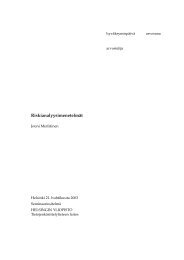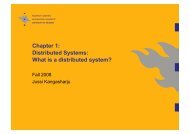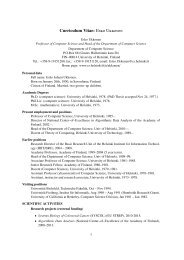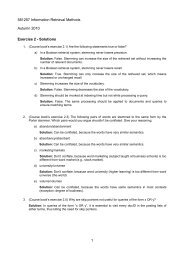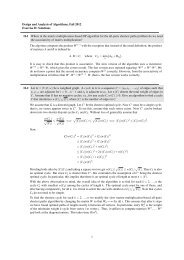Calculating trust in sensor networks
Calculating trust in sensor networks
Calculating trust in sensor networks
You also want an ePaper? Increase the reach of your titles
YUMPU automatically turns print PDFs into web optimized ePapers that Google loves.
Another method of us<strong>in</strong>g the hop count of a route would be to count the multiplied<br />
reputations of the route with the hop count:th root:<br />
<strong>trust</strong>worth<strong>in</strong>ess(x, y) = n<br />
�<br />
�<br />
�<br />
� n �<br />
reputationi(i − 1)<br />
One major benefit of this approach is that lower reputations will have a larger impact on<br />
the total <strong>trust</strong>worth<strong>in</strong>ess of the route.<br />
To test the different metrics described above, we def<strong>in</strong>e three test scenarios and calculate<br />
the <strong>trust</strong>worth<strong>in</strong>ess with three of the four metrics, route average, hop count:th root and<br />
square root. We will omit the aggregated-metric, as it is not easily compared to the other<br />
three metrics. The most we can answer about the aggregated method is that the result<br />
will lower with every hop, f<strong>in</strong>ally result<strong>in</strong>g <strong>in</strong> very low numbers.<br />
Figure 8: Different methods of calculat<strong>in</strong>g cha<strong>in</strong>s of <strong>trust</strong> <strong>in</strong> a route consist<strong>in</strong>g of good,<br />
then bad, then good nodes.<br />
Figure 8 shows the <strong>trust</strong> calculations of the three metrics when a packet traverses 11 nodes.<br />
The reputations of the nodes decrease steadily from 0,9 to 0,1 as the packet moves from<br />
hop to hop and then rise steadily back to 0,9. The average and hop:th root-methods each<br />
react similarly to the reputations with the hot:th root-method return<strong>in</strong>g more pessimistic<br />
i=1<br />
42






